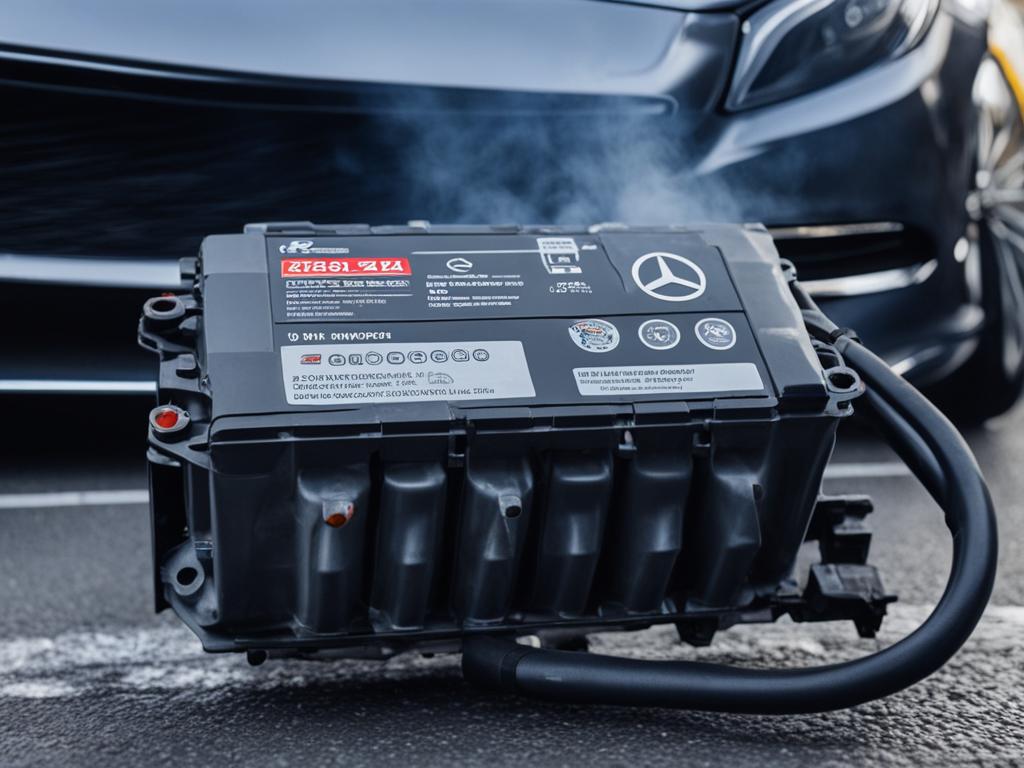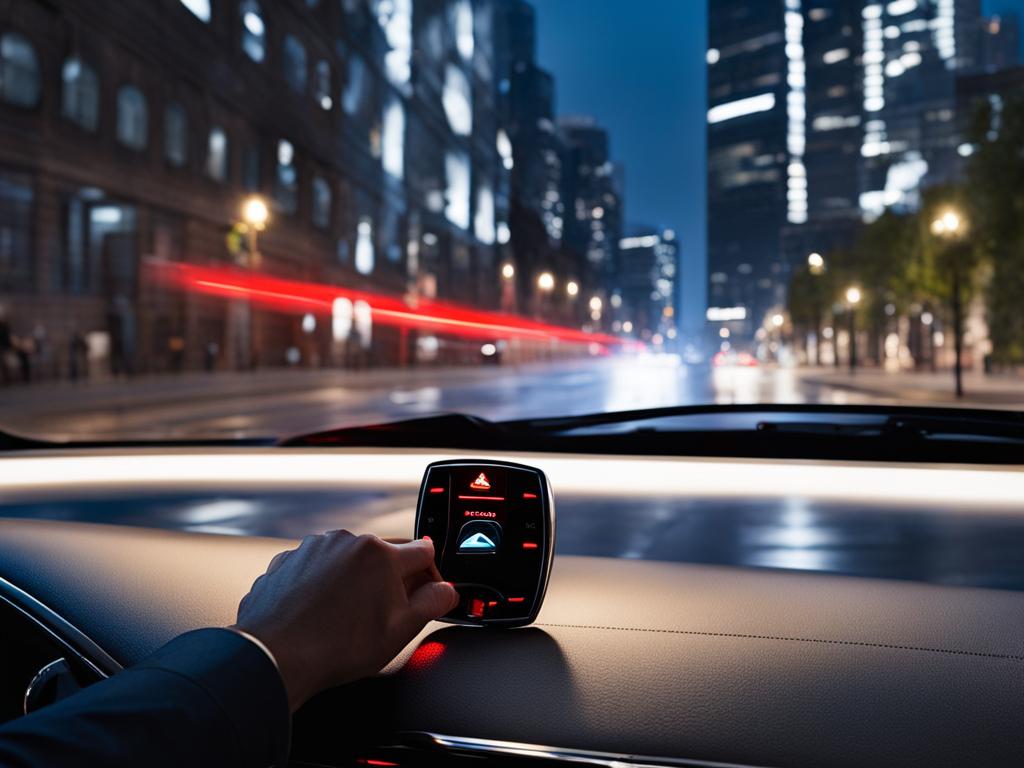Mercedes Feature: Stop Vehicle, Keep Engine Running
Mercedes-Benz vehicles, particularly 2015 and newer models such as the C300, GLC300, and E300, sometimes display a dashboard malfunction message that reads “Stop the vehicle, shift to P, leave the engine running” due to low voltage conditions. This warning is an essential safeguard designed to prevent further battery discharge and is automatically reset after approximately ten minutes. As a Mercedes-Benz owner, it is crucial to understand the underlying cause of this warning, usually attributed to a depleted battery, and maintain a charge of at least 12.5 volts for optimal operation.
Key Takeaways
- Mercedes-Benz vehicles may display a “Stop the vehicle, shift to P, leave the engine running” warning due to low voltage conditions.
- Affected models include the C300, GLC300, E300, and other models from 2015 and newer.
- The warning serves as a safeguard against further battery discharge and resets automatically after around ten minutes.
- The underlying cause is typically a depleted battery, emphasizing the need for maintaining a charge above 12.5 volts for optimal operation.
- Proper understanding and maintenance of your vehicle’s battery health are crucial to prevent this warning and ensure the continued performance of your Mercedes-Benz.
Understanding the “Stop Vehicle, Keep Engine Running” Feature
The “Stop Vehicle, Leave Engine Running” message serves as a warning system for Mercedes-Benz owners, signaling potential issues with the vehicle’s voltage regulator – the component responsible for adequate battery charging. This automatic response primarily occurs in scenarios where the vehicle is not driven for extended periods or experiences only short trips, leading to insufficient charge maintenance.
Reasons Behind the Feature Activation
Symptoms triggering this message include the appearance of battery-related error messages on the instrument cluster and functions like accessory convenience features being temporarily disabled to conserve power. This is a proactive measure taken by the Mercedes engine auto stop technology to alert drivers to potentially hazardous situations.
Which Mercedes Models Are Affected?
The error message regarding stops and engine operation can affect a broad range of Mercedes-Benz models, including, but not limited to, the C300, GLC300, and E300. It is not limited to a single model or class, reflecting a widespread application across the Mercedes-Benz lineup catering to various consumer preferences.
The Role of the Voltage Regulator in Your Mercedes
A vehicle’s voltage regulator plays an essential role in preserving battery life by maintaining the charging system’s stability. For Mercedes-Benz owners, a malfunction in this regulator can lead to the “Stop Vehicle, Leave Engine Running” message, which is the vehicle’s way of alerting drivers to let the engine run and thus enable the alternator to charge the discharged battery. Identifying potential voltage regulator issues early can prevent the inability to start the vehicle and avoid potential towing and repair costs associated with Mercedes battery charge maintenance.
| Model | Years affected |
|---|---|
| Mercedes C300 | 2015 and newer |
| Mercedes GLC300 | 2015 and newer |
| Mercedes E300 | 2015 and newer |
Identifying Symptoms and Error Messages
Mercedes stop engine running when parked situations and Mercedes instrument cluster error messages can signify potential voltage issues. While diagnosing these symptoms, it is essential to be familiar with the wide range of error messages that may appear on the Mercedes-Benz instrument cluster. Some common warning signals include:
- “12 Volt Battery See Operator’s Manual”
- “Shift to P, Leave Engine Running”
These error messages give drivers the opportunity to address the potential issues before they turn critical. The presence of a battery symbol with an exclamation mark is another visual cue that suggests a voltage drop, requiring the driver to take necessary actions promptly.

Ignoring error messages can lead to additional component stress or even damage to the automatic transmission. Consulting the Mercedes 12 volt battery operator’s manual can provide further insight into these warning signals.
In order to prevent potential inconvenience or costly repairs, it is vital for drivers to be aware of these warning signals and promptly adhere to the instructions given by the vehicle’s system whenever they appear.
Mercedes Stop Vehicle Leave Engine Running Warning: Steps You Should Take
When encountering the “Stop Vehicle, Leave Engine Running” warning, it is vital to take immediate actions to avoid potential complications that could lead to additional maintenance costs. In this section, we will discuss the necessary steps to take when faced with this warning, measures to mitigate battery discharge, and procedures to understand battery recharging.
Immediate Actions Upon Seeing the Warning
Upon receiving the stop vehicle leave engine running warning, park your Mercedes safely and allow the engine to run, undisturbed, in the ‘Park’ mode. Do not leave the vehicle unattended during this period. To speed up the reset process, which could take ten to twenty minutes, minimize the use of power-consuming features such as chargers, lights, and heated seats. Ignoring these warnings and failing to take immediate action might necessitate auxiliary battery or alternator replacement in due course.
Mitigating Battery Discharge: What to Avoid
To mitigate battery discharge when receiving the “Stop Vehicle, Leave Engine Running” message, avoid using electrical components such as vehicle lights, chargers plugged into auxiliary outlets, and the entertainment system. The purpose behind this advice is to reduce the vehicle’s power consumption, thereby giving the alternator an optimal environment to re-charge the main battery without unnecessary load. Practicing Mercedes car battery conservation can go a long way in maintaining your vehicle’s health.
Understanding the Recharge Procedure and Timeframe
When faced with the “Stop Vehicle, Leave Engine Running” warning, allow your Mercedes engine to idle for a period, typically between ten to twenty minutes, facilitating battery recharge through the Mercedes battery recharge procedure. If the battery requires additional attention, connecting the charger to the battery via the appropriate terminals in the engine bay or directly if accessible may be recommended. Regularly driving or using a trickle charger can further maintain the battery in an optimal charged state, preventing the recurrence of such warnings.
Investigating Common Causes for Battery Power Issues
Understanding the reasons behind battery power issues in Mercedes-Benz vehicles helps identify the necessary corrective actions to take. In this section, we will discuss potential electrical and hardware culprits, evaluate accessory use and driving habits, and emphasize the importance of battery maintenance and replacement.

Possible Electrical and Hardware Culprits
Often, mercedes engine auto stop issues can be traced back to electrical or hardware problems such as a parasitic draw, a defective alternator or voltage regulator, loose connections, and improperly maintained serpentine belts. For persistent error messages, conducting a full system scan with a dedicated Mercedes-Benz scanner can help pinpoint the issue. Charging the battery with a 12-volt trickle charger or opting for a mercedes battery replacement are viable solutions to rectify faults in the vehicle’s power system.
Analyzing Accessory Use and Driving Habits
Excessive use of accessories like the radio or air conditioning and frequent short trips can contribute to mercedes stop engine while parked warnings, as they lead to undercharged batteries. Ensuring a regular driving pattern with sufficient durations and distance allows the alternator to adequately recharge the battery, preventing the stop vehicle and engine running warnings from frequently occurring. Being mindful of mercedes accessory usage and modifying mercedes vehicle driving habits are essential to maintaining optimal battery performance.
The Importance of Battery Maintenance and Replacement
Proper battery maintenance is critical in preserving the longevity of a Mercedes-Benz battery. Ensuring clean and secure terminals and battery posts can prevent mercedes stop engine running when parked problems. Regular checks and replacements of batteries after the approximate 4 to 5-year lifespan are recommended, as is ensuring minimal corrosion on the battery terminals. Adhering to mercedes battery maintenance principles can enhance mercedes battery longevity and avoid compromised vehicle performance and costly battery replacements.
Mercedes Engine Auto Stop: Preventive Measures
As a Mercedes-Benz owner, preserving the performance and longevity of your vehicle, particularly the engine auto stop features, requires implementing a range of regular precautions in congruence with specific driving habits.
The following preventative measures can minimize disruptions stemming from low battery voltage and ensure seamless operation of your vehicle’s engine stop technology:
- Maintain battery health through periodic checks, cleaning of terminals, and timely replacements, as needed.
- Avoid excessive short trips that do not allow ample time for the alternator to recharge the battery.
- Minimize the use of power-consuming accessories such as chargers, entertainment systems, and heated seats, particularly when the engine is idling or the vehicle is stationary.
- Invest in a high-quality 12-volt trickle charger to maintain optimal battery charge levels when the vehicle is parked for extended periods.
Consistent adherence to these measures can mitigate the activation of the “Stop Vehicle, Leave Engine Running” message and reassure optimal function of your Mercedes-Benz vehicle.

A proactive approach in addressing possible underlying voltage regulator issues or battery health concerns can significantly contribute to a hassle-free driving experience. When in doubt, seeking professional assistance from a Mercedes-Benz technician for thorough diagnostics can provide valuable insights and recommendations for maintaining the vehicle’s performance and long-term reliability.
Conclusion
The Stop Vehicle, Shift to P, Leave Engine Running warning on Mercedes-Benz vehicles is a critical indicator of charging system malfunctions, necessitating immediate action by the driver to avoid potential vehicle downtime. By following a comprehensive Mercedes stop vehicle leave engine running guide, drivers can ensure the proper response and steps taken to maintain operational integrity.
Regular maintenance and giving requisite attention to Mercedes battery health are essential preventative measures, especially for preserving battery life. This includes routine checks and repairs, as well as understanding the vehicle’s technology. Implementing these practices helps to uphold the vehicle’s performance and prevents the recurrence of the warning message.
Ultimately, Mercedes engine stop technology functions effectively when the vehicle is well-maintained and operated as per the manufacturer’s recommendations. Addressing warnings promptly and investing in proper battery care are advantageous measures that ensure not only convenience but also the safety and reliability of your Mercedes-Benz vehicle.
FAQ
What triggers the “Stop Vehicle, Leave Engine Running” message in Mercedes-Benz vehicles?
The message is triggered by low voltage conditions, typically resulting from a depleted battery. It serves as a warning to prevent further battery discharge, signaling potential issues with the vehicle’s voltage regulator.
Which Mercedes-Benz models are most likely to display this message?
The message can affect a wide range of Mercedes-Benz models, including, but not limited to, C300, GLC300, E300, C200, C43 AMG, C250, C180, and other post-2014 vehicles. It is not limited to a single model or class.
How long does it typically take for the warning to reset after following the instructions?
After stopping the vehicle, shifting to ‘Park,’ and leaving the engine running, the warning should reset after approximately ten to twenty minutes. Minimizing the use of power-consuming accessories can expedite the reset process.
What steps should be taken to mitigate battery discharge while the engine is running?
To reduce power consumption, avoid using electrical components such as vehicle lights, chargers plugged into auxiliary outlets, and entertainment systems. This allows the alternator to recharge the battery without unnecessary load.
How can drivers maintain their battery in optimal condition to prevent recurrences of this warning?
Regular driving with sufficient durations and distance helps the alternator recharge the battery. Using a trickle charger and maintaining clean, secure battery terminals and battery posts further aid in optimal battery performance.
What are common causes behind battery power issues in Mercedes-Benz vehicles?
Common causes include electrical or hardware issues such as parasitic draw, defective alternator or voltage regulator, loose connections, and improperly maintained serpentine belts. Excessive use of accessories and frequent short trips can also contribute to battery problems.




